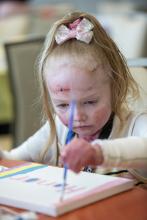Navigating School with EB: A Parent's Guide to a Successful School Year

Stores are swapping out displays of sunscreen and pool floats for pencils and paper. It's time to transition from the lazy days of summer, back to the classroom.
I get many calls about navigating school with Epidermolysis Bullosa (EB) throughout the year. Sending your child to school for the first time is an emotional milestone for any parent. When your child has the unique needs that come with EB, sending them to their first day of school can be extremely daunting. As kids grow and transition from one school to the next, you may encounter new navigation challenges requiring more creative adaptations. I wanted to go over a few topics that may be helpful to you as you advocate for your child with EB during the school years.
If I could give parents one piece of advice, it would be to find your child’s school nurse and befriend them. The nurse should be your ally and guide you through this process. The nurse may not be familiar with EB yet, but they should be willing and eager to learn from you, and the resources available. The school nurse’s role is to educate, train, delegate, coordinate, and supervise the school staff who provide care to your child. The nurse will collaborate with you and your child’s health care provider to write an Individualized Health Care Plan (IHP) to accommodate your child’s needs and keep them safe at school.
A child with EB should have an IHP in place. An IHP is a document that addresses how the student’s health needs will be met within the school or childcare setting. The IHP lists important medical information such as diagnoses, allergies, and emergency contact information. It should include any medical orders needed. It may include transportation needs, academic accommodations, activity restrictions, mobility assistance, weather considerations, hygiene needs, feeding/swallowing plan, fragile skin precautions, delegated procedures such as lancing blisters, safety issues, infection concerns, medication management, when to notify the parents, when to call 911, and what to do during emergency situations/evacuations. These health plans are written by the school nurse in collaboration with information provided by the parents, and the health care providers. The IHP is reviewed and signed by the parents, the school and often the primary care provider. The IHP is updated as needed at least annually.
It is important that you provide the school with the information, supplies/dressings, and trust they will provide safe and consistent care for your child. Be proactive in helping the school prepare for the needs of your child and communicate with your school when there are changes to your child’s physical or mental health that may impact the school day. Your child’s school should be included as an active member of your child’s health care team.
Most schools are very welcoming and will make every effort to meet your child’s needs. If you should encounter pushback from your school, it can be helpful to know the rights of your child. Children with disabilities have a protected right to attend school in the least restrictive environment from age 3 through age 21. The two important pieces of legislation that protect these rights include:
- IDEA: Individuals with Disabilities Education Act: Ensures students with a disability are provided a free appropriate public education (FAPE).
- The Americans with Disability Act of 1990 and Rehabilitation act of 1973-Section 504: Prohibits discrimination based on a disability and prohibits recipients of federal funds to discriminate.
A child with EB-related needs should request a 504 or an evaluation for an Individual Education Plan (IEP). Both a 504 and IEP are federal initiatives that help students with disabilities receive FAPE. Both a 504 and an IEP can include accommodation and modifications. A 504 does not provide specialized instruction, but an IEP does. An IEP can include services such as therapies, adaptive physical education, or a 1:1 health paraprofessional to help your child safely navigate the classroom and playground. A student does not need to have learning impairments to qualify for an IEP. A parent can ask for IEP evaluation for their child. Most students with EB qualify for an IEP based on disability.
In my experience, children with EB tend to be very bright, curious, and resilient. Like all kids, they enjoy learning new things and making friends. A supportive school environment can challenge children in new ways, expand their world, and promote confidence in themselves and their abilities. It is important for children to attend school on a regular basis whenever possible to foster learning, development, and emotional well-being. I realize this may still seem overwhelming to parents working up the courage to launch their little one. Just go back to the first 2 steps. Enroll them in school and give your friendly school nurse a call. They will help you the rest of the way. I am always here and happy to talk to parents and school nurses who need support. You can reach me through our contact form here, phone line (212) 868-1573 x107 or email at nurse@debra.org.
Have a Wonderful School Year,
Catherine Doernbrack MSN, RN, CPNP-PC
EB Nurse Educator at debra of America




